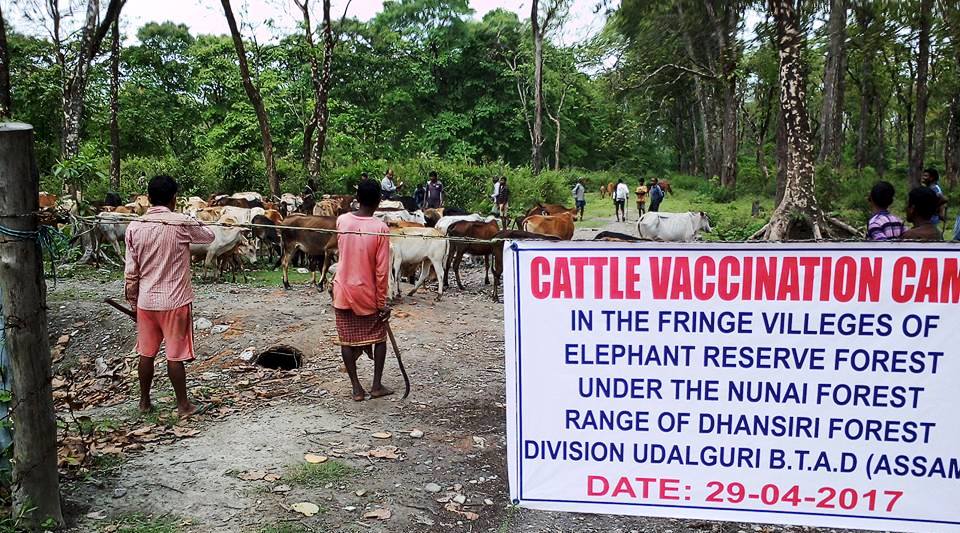Streamlining private sector driven vaccination of livestock in forest fringe villages of India
Mass vaccination of livestock in forest fringe villages is an important and relatively common activity in Indian context to address the threat of disease transmission between domesticated livestock and wildlife. In recent years, grant based or voluntary free livestock vaccination in forest fringe area has become a favorite activity for a number of NGOs in India. Though private participation to assist the government in animal disease control is a welcome move, what is missing is the planned, targeted and protocol based approach.
Photo source: Mr Dibakar Das
Vaccination of livestock in fringe villages must carefully consider specific circumstances, follow protocols and target livestock owners for maximum coverage and outcome. The government should facilitate this by making available information pertaining to socio-economic and epidemiological risk profiling of fringe villages. For targeted campaign, public investment is also necessary to ensure mandatory identification of households rearing livestock in forest fringe areas. Detail record of any initiatives related to vaccination in forest fringe areas must feed into a transparent public information system to know vaccination coverage at any point and to prevent duplication. Independent studies are a must to confirm the desired post vaccination immunity status in identified villages.
Vaccination to control animal diseases is a public function and private sectors are considered to play only a complimentary role. Sharing of information with nodal government authority about mass vaccination program conducted by any individual NGO is therefore essential to ensure efficient delivery of this public function. In this regard one can refer to the notified rules under Prevention and Control of Infectious and Contagious Diseases in Animals Act’2009 (notified by Ministry of Agriculture and Farmers’ Welfare on 14th December’2010). As per the rules, state governments should notify private agencies competent to vaccinate livestock in any given area. Such agencies must issue a certificate to the owner of livestock within three weeks and maintain proper record of vaccination within their jurisdiction. There are standard formats for giving certificates, which must be bilingual (at least one vernacular language) so that livestock owners understand and can use such certificates when needed for making decisions.
NGOs and other private agencies can streamline their activity by considering following five aspects:
The first aspect is the careful consideration of available epidemiological information on diseases in the targeted villages and risk score thereof. This is a prerequisite to decide on priority villages and use of any particular vaccine. Guidance of government agencies should be taken in this regard. Sourcing of quality and government approved vaccines is critical in this connection. It is to be noted that farmers should be informed adequately about the importance of any select disease and vaccination campaign thereof to ensure larger and voluntary participation.
Logistics is the second most important factor. NGOs must ensure adherence to manufacturers guideline on cold chain maintenance and ensure timely delivery of vaccines to field team at the last mile. Use of trained cadres under supervision of registered veterinarians are a must to ensure compliance to protocols related pre, during and post vaccination care. The arrangements should be done to ensure maximum possible coverage. This is particularly important for achieving the herd immunity and to stop occurrence of the disease in future. Herd immunity is a form of immunity that occurs when the vaccination of a significant portion of a population (or herd of animals) provides a measure of protection for animals that have not developed immunity. It arises when a high percentage of the population is protected through vaccination making it difficult for a disease to spread because there are so few susceptible animals left to infect.
The third important aspect is the follow up vaccination campaigns. Mass vaccination particularly when repeated at regular intervals can result in near elimination of a disease in the target population. Similarly, timing of the campaigns is important. NGOs should follow vaccination schedules that are prepared in consultation with local government authorities.
The fourth important aspect is the need to maintain the trust and confidence of stakeholders on vaccination. Vaccinating stressed animals, after outbreaks are already underway or covering too small a percentage of the population, will naturally result into many animals becoming sick despite vaccination. Though risk of vaccine failure cannot be completely eliminated, NGO’s must plan to minimize risk and communicate to stakeholders effectively for ensuring continued trust and confidence.
Vaccination may reduce the likelihood or the severity of illness but may not prevent infection. Vaccinated animals may still get sick because pathogens (disease causing organisms) different from the vaccine were involved, because the immune system was overwhelmed by the infection, or because the vaccinated animal failed to develop a protective immune response. The fifth important aspect, therefore, is to ensure education of stakeholder not to place all of their faith in vaccination and neglect other necessary measures for disease prevention such as initiatives aimed at reducing the contact between wildlife and livestock in protected areas viz. fencing, restricted grazing, popularization of stall feeding etc.






